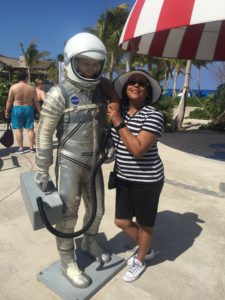Grand Turk is a beautiful island in the Turks and Caicos Islands. My husband, I recently visited the island during our vacation. We found Grand Turk to be quaint and delightful.
[featured-image single_newwindow=”false”]
Whenever we visit a new place, my husband and I always explore the historical significance of our destination.
Grand Turk is a British Overseas Territory country. Grand Turk is the territory’s capital and has the second largest population of the Turks and Caicos Islands.
The island is 6.9 square miles and inhabited by about 5,000 residents. The island has a rich history, which dates back to 700 AD. The first inhabitants were Tainos, who migrated north through the Caribbean.
The “bean-shaped” island is also believed to be the first point of landfall for Christopher Columbus’s voyage to the New World. Disease and slavery took a heavy toll on the Tainos and population disappeared in the 1500s.
The island was largely uninhabited until the late 1600’s when settlers from Bermuda came to the island for salt production. At the height of production in the 1900s, over two million bushels of salt was being shipped from Grand Turk annually.
As more efficient ways to produce salt were developed, the island found itself at an economic crossroads. In the 1950s, the U.S. Air Force built two bases on the island. In 1962, Grand Turk entered the history books again when Colonel John Glen stepped on the island after orbiting the earth.

In 1983, the Air Force bases closed, the island’s economy once again transitioned. Tourism became the primary economic engine for the island. Before hurricanes Irma and Marie, Grand Turk was a vacation hotspot. The white sandy beaches and quaint Front Street combined with an average temperature of 80℉ create a picture-perfect vacation environment.
To explore the island, my husband and I took a Segway tour. There where nine individuals in our group. Our tour guide Brittany was a Grand Turk native. She expertly lead us around the island and shared its rich history.
[callout]During our tour, we were instructed to stay in line and follow our leader, Brittany.[/callout]
One member of the group was a type A individual, who didn’t like to wait. As we toured the island, she cut off two people, so she could be up front behind our guide.
As I watched the individual during the tour, I compared her behavior with our tour guide. Brittany was pleasant and patient. She adjusted the pace of the tour to accommodate the individuals in the group. Although the island had been devastated by the storm, Brittany painted a picture of the original beauty of the island.
On the bus back to the ship, I thought about the difference between Brittany and the tourist. As I reflected on my own behavior, I was reminded of the times when I was impatient or demanding. I asked myself, as a leader am I modeling the behavior I expect from others?
[shareable cite=”Dr. John C. Maxwell”]Followers may doubt what their leaders say, but they usually believe what they do”[/shareable]
According to my mentor, John Maxwell, people do what people see. As the leader, people will take their cue from you.
Are you modeling the behavior you expect from others?
Your leadership guide,
Kim
Dr. Kim Moore | Your Leadership Guide | kimdmoore.com

0 comments